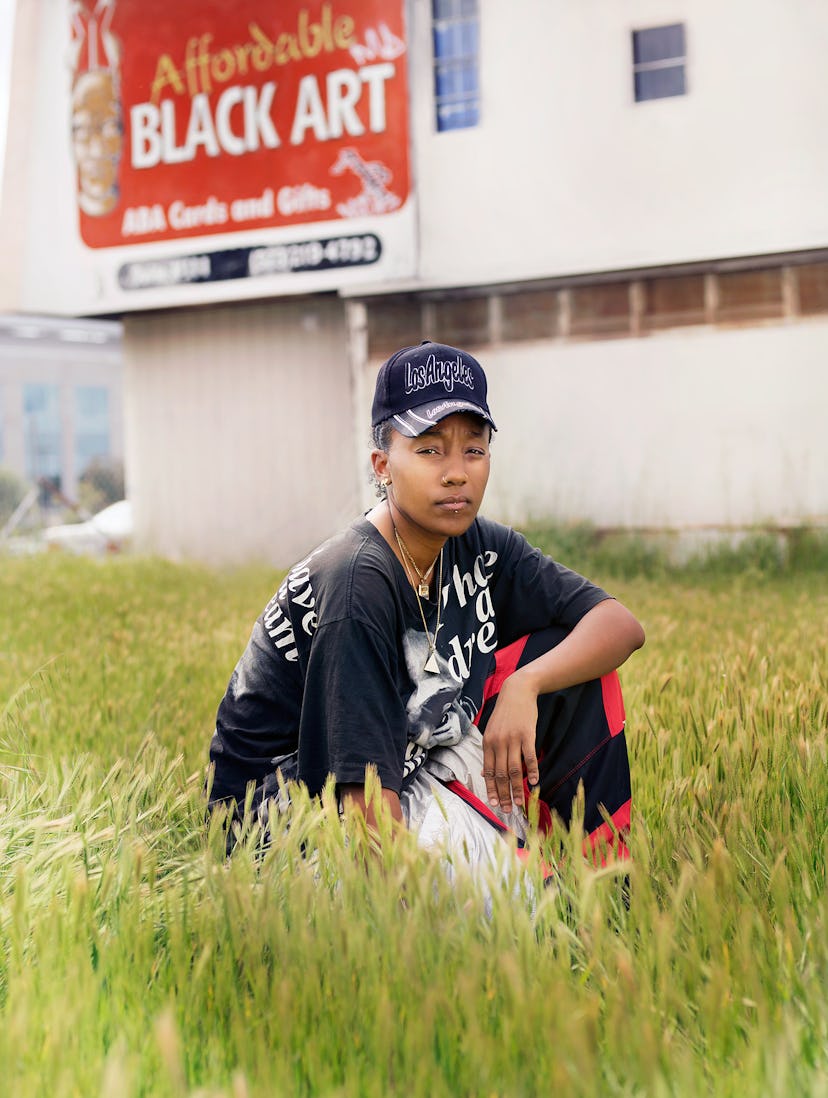Lauren Halsey, the Artist Building Black Lives Into the Establishment
The rising star creates poetic urban installations—sometimes directly in a museum’s infrastructure.

When Lauren Halsey was getting her B.F.A. at the California Institute of the Arts after studying architecture in community college, she began making supersize photoshopped collages that brought together L.A. imagery and ancient sites like Cleopatra’s Pool, in Turkey. “I was remapping and remixing L.A. city blocks with these images from National Geographic,” she says, “and bringing in local heroes and things I was collecting at the time, like figurines from discount stores and menus from the burger joint. I was ‘funkatizing’ the city.” Parliament-Funkadelic’s music, she stressed, was a source of inspiration not just for the way it layers sounds but for how it celebrates “the full spectrum of blackness.”
Since graduating, Halsey, 31, has been creating densely textured installations that reference the urban detritus, trauma, and optimism associated with the South L.A. area where she grew up. At the Museum of Contemporary Art, Los Angeles last year, she built a psychedelic cave that brought together churchgoing black figures, Black Panther–themed carpets, and Egyptian sphinxes and ankh symbols. She is currently developing her biggest project yet, The Crenshaw District Hieroglyph Project, a freestanding four-walled structure that will consist of large concrete blocks engraved with contemporary hieroglyphs by locals—a monument to the community, from the community. Last year, her prototype for the project, which was included in the Hammer Museum’s 2018 “Made in L.A.” biennial, earned her the $100,000 Mohn Award for artistic excellence, and she’s been in great demand since. She was picked up locally by David Kordansky Gallery, and in May will unveil a new piece in Paris, at the Fondation Louis Vuitton, that will allow her to do “cultural archiving” of that city. Also, on Wednesday, she’ll present a commission for the Frieze art fair in New York, showcasing her signature architectural columns teeming with what she describes as “neighborhood ephemera, images of do-rag models, black ideological pyramid worlds, and Afrofuturist myths,” and dedicated to the slain rapper Nipsey Hussle, an important figure of her L.A. community.
An installation view of *The Crenshaw District Hieroglyph Project* (Prototype Architecture), 2018, at the Hammer Museum.
As Halsey sees it, the street life of Crenshaw Boulevard is worth preserving in hieroglyphic form. “Crenshaw is where you are seen and want to be seen, whether it’s your body, your aesthetic, your hair, or you in your lowrider car,” she says in her temporary studio on the rooftop of the Los Angeles Athletic Club, where she has views of the city skyline and a court to play basketball, a longtime passion. “Crenshaw was the nucleus of black L.A. when I was growing up.” The artist Charles Gaines, who was one of her professors at CalArts, has become a sounding board now that her career is moving at such a fast pace. “I will ask him everything, from ‘How do I write an invoice?’ to ‘What do you think of this idea for a show?’ ” They also shoot hoops together at the club. “She is serious,” Gaines says of Halsey on the court. “She could have been a pro.” He is also a fan of her work in the studio. “She’s an extraordinary, imaginative thinker—that was the first thing I noticed as her teacher. You’d have to be blind not to see that.”
A detail of *That Fuss Wuz Us*, 2018.
Her work owes much to the great African-American assemblage tradition of the L.A. artists Noah Purifoy, John Outterbridge, and Betye Saar, who impressed Halsey early on with her mystical and autobiographical 1969 window-frame construction Black Girl’s Window—“I saw myself in it,” Halsey says. But her art also comes from a more personal place, as someone who loves to amass, accumulate, and archive. “My parents gave me a lot of freedom in my bedroom; it was always a kick-it spot for my friends, and always changing identity,” she says. “I had a huge collection of incense and oils, plants, business cards, vernacular graphic design like handmade party fliers and hair-salon coupons, every issue of Vibe magazine ever, and also wrestling stuff—I had all the posters of the Rock.” It’s no coincidence that Halsey currently tries to work with friends, creating a loose collective, with her studio as another sort of hang-out space. “My work involves a lot of labor, lifting and moving heavy things.”
Another detail of *That Fuss Wuz Us*, 2018.
For the past month, she’s been living and working in Paris, creating installations she calls “funk mounds” that have “vignettes and plants” like the MOCA cave. “It’s my favorite thing, this kind of immersion into a city,” she says. It’s a big step for the artist in some ways, plunging into a new cityscape as she sorts through “what a black Paris aesthetic might be.” But she isn’t worried about losing touch with her roots in L.A., where her family has lived since the 1930s. “I just learned about the black jazz scene on Central Avenue in the ’30s via an image I saw of my grandmother and her twin kicking it with Duke Ellington in a club. So I want to think about these moments in Los Angeles history that I haven’t tapped into yet.”
Related: Inside the Dramatic Makeover of L.A.’s Thriving Art World